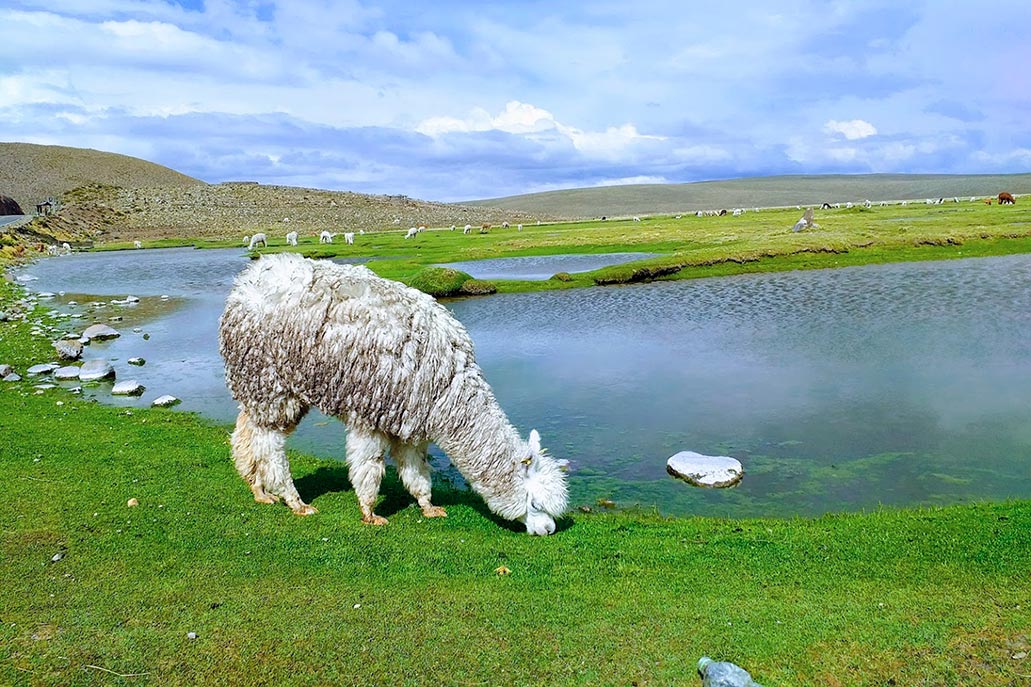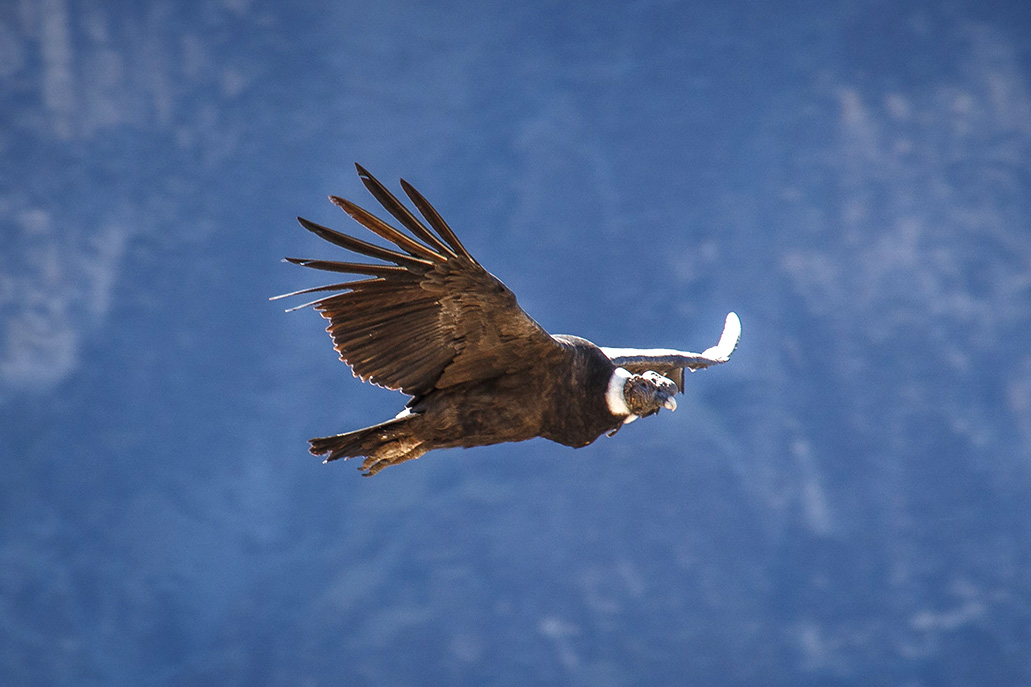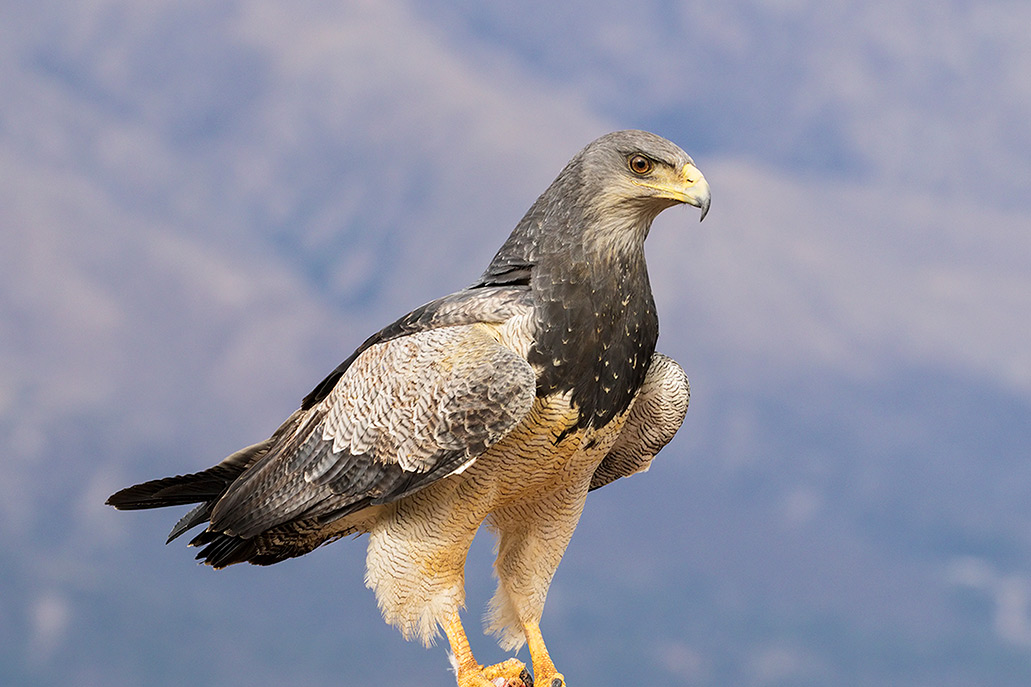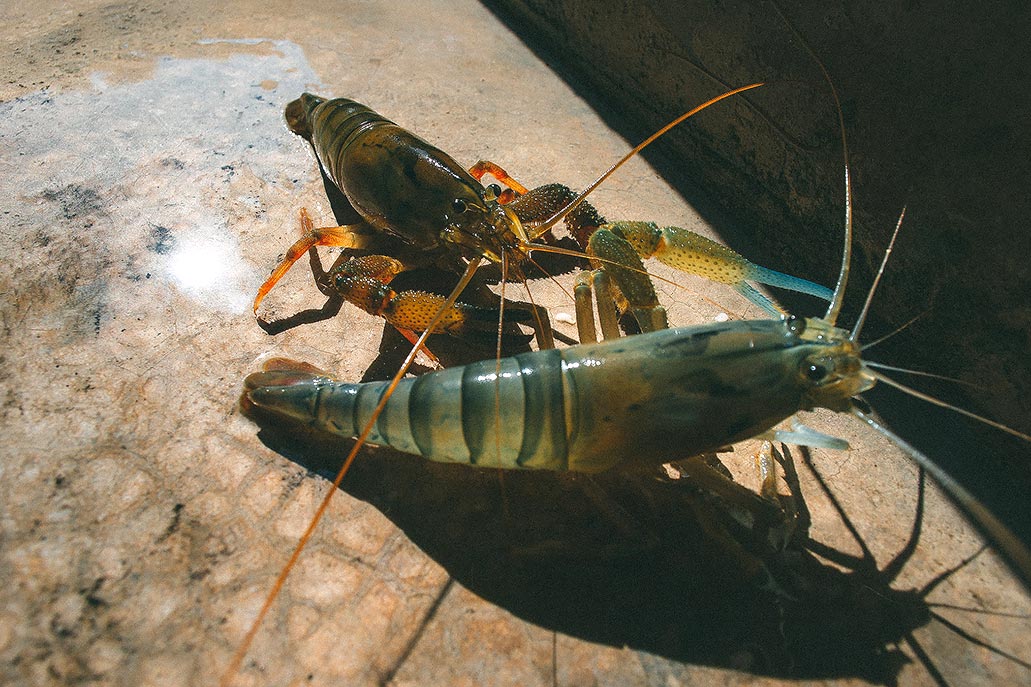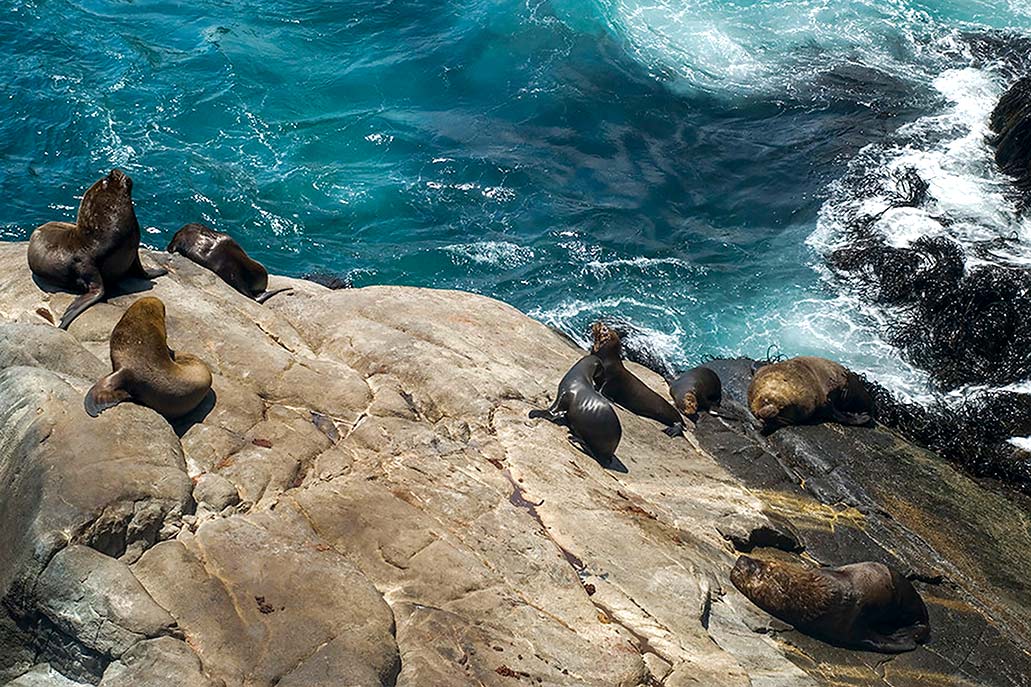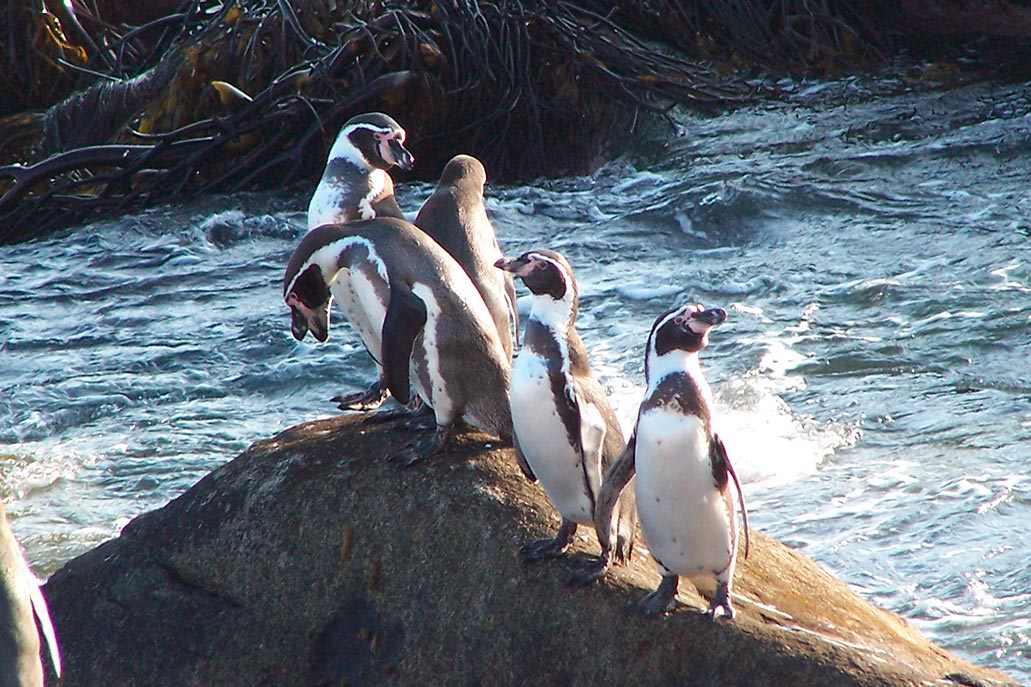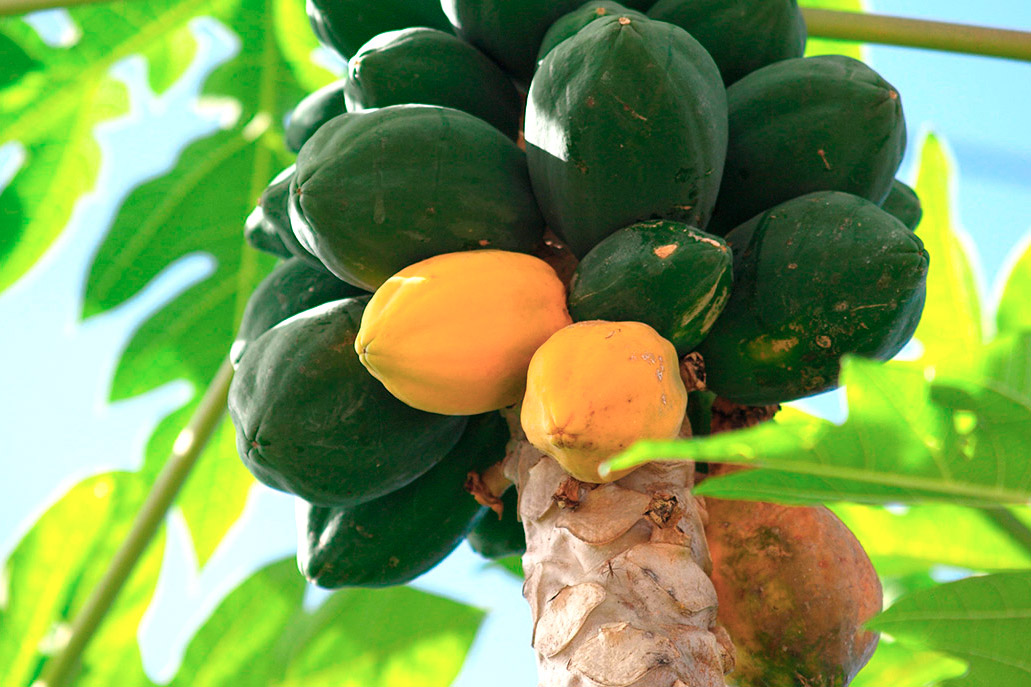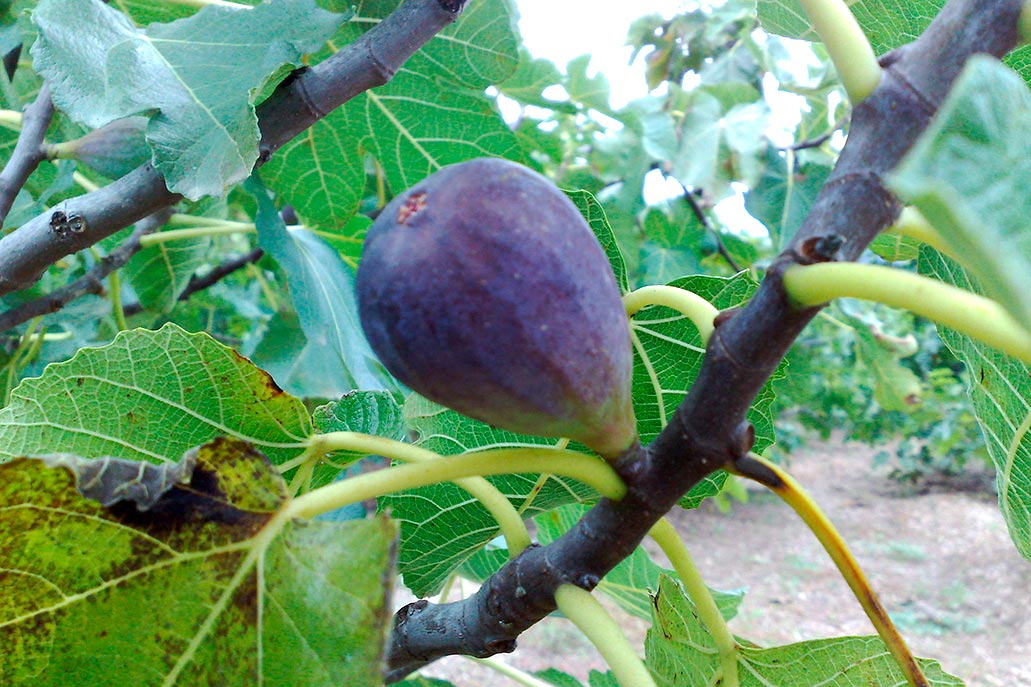Fauna and flora in the Arequipa region
A great variety of geographical spaces can be found in the Arequipa territory. In this sense, finding a great variety of flora and fauna is normal. As an example, we can see that Arequipa is home to one of the tastiest animals in Peruvian cuisine: the river shrimp. We can also find the Andean cat and in the sea, a variety of fish and birds.
Content
Location and climate of the Arequipa region
The region of Arequipa is located between the Andes and the sea, so it shows a fairly complex and rugged space. It has an area of 63,345 square kilometers. It has Andean valleys, pampas, a volcanic chain, high Andean plateau and deserts that border the sea. Although the coast is quite rocky, there are open beaches like spas, such as Mejía, Mollendo and Camaná. Throughout the coast, the climate is humid and cloudy and lacks precipitation, which is why it is quite arid. While in the ascent towards the Andes the climate varies according to the increase in altitude. In these places rainfall increases and temperature variations vary greatly during the day and night.
Fauna in the Andes and the valleys of Arequipa
Andean flamingo (Phoenicoparrus andinus)
Known in these lands as parihuana. It is one meter tall and when flying it has a wingspan of 1.60 meters. The color of its plumage is pink with white pigmentation, near the chest it becomes darker, being almost violet.
In Arequipa it can be found in the Reserva de las Salinas and Aguada Blanca, while they rest on their migration. They constantly search for wetlands where at certain times they proceed to reproduce and in search of food. These birds nest mainly in the Salar de Atacama. After ten days of hatching the eggs, the new hatchlings are cared for by wet nurses who care for and feed them, the rest of the adults move to other lagoons. They are cared for for three months, after which they begin to fly and move south.
Abraham Valdelomar, a writer from Ica, narrates in one of his stories the famous dream of Don José de San Martín. Who, falling asleep on the islands of Paracas, dreams of a beautiful country where a flag inspired by the colors of the parihuana waved: red and white. Colors that would be taken for the Peruvian flag.
Andean fox (Lycalopex culpaeus)
Known locally simply as a fox. It has the average size of 60 centimeters high and long, together with its tail, it reaches 90 to 110 cm. It has a thick and relatively long coat, to adapt to cold temperatures. A grayish back and the rest of the fur is yellowish, the ears with black tips and a long tail that is quite thick or fluffy with black nuances, the belly is light in color.
The Andean fox is solitary. In Arequipa it can be found in the Salinas and Aguada Blanca Reserve. It usually takes refuge in burrows and some caves. It has a travel area, where it hunts and raises its young, of 11 kilometers. They tend to be quite territorial even with the opposite sex.
The diet of the Andean fox is meat, it feeds on rodents, birds, some reptiles, eggs and invertebrates. Sometimes it feeds on fruits. When it has the opportunity, it goes out to hunt the young of vicuñas and guanacos, sometimes it feeds on carrion.
These animals usually reproduce from August to October. The gestation of mothers has an average of 55 to 60 days. New litters are generally 3 to 8 pups. These pups are fed for a few months. The male and female care for the young. After 3 months, the calf learns to hunt through games. They usually live around 11 years, reaching sexual maturity after a year of life.
Andean Condor (Vultur gryphus)
The Andean condor is considered by many people as the “king of the Andes”. It has a height of 130 to 142 centimeters, while in flight and with outstretched wings it reaches a wingspan of 330 centimeters. The plumage of this gigantic bird is black with some white pigmentation on the wings and around the neck, these being its most outstanding characteristics.
In Arequipa, this majestic bird can be found in the Colca Valley and in the Salinas and Aguada Blanca Reserve. They feed mainly on carrion thanks to their good sense of smell. Due to its great sense of smell, it is considered one of the seven species of American vulture, for having these strange or unusual characteristics in birds.
This bird covers a large part of the Andean territory, in some cases reaching the coast of Paracas. This wide territory of action, poaching, climate change, environmental pollution and the difficult reproduction of these birds, positioned them as an endangered species. Its flight in thanks to the air currents produced by the thermal rise. You can plan large extensions without any problem.
The Andean condor, sexually matures only at 5 years old, there were even reports of first-time mothers only at 11 years old. They can only have one calf every two or three years. It is monogamous in behavior and both parents incubate the egg. These young stay with their parents for up to two years. They can live up to 50 years in the wild while in captivity up to 80.
Andean cat (Leopardus jacobita)
The Andean cat is a small feline, but quite robust. The total length of an adult Andean cat is between 74 cm to 85 cm. With a fairly long tail of approximately 41 to 48 cm. The fur is ash gray with reddish brown or yellowish spots, arranged vertically that culminates in the tail that has nine rings of the same color as the spots. It weighs up to 6 kilograms.
This feline is found in the Salinas and Aguada Blanca Reserve, also in the Cotahuasi Sub-basin Landscape Reserve. It feeds mainly on the mountain vizcacha or chinchillon, other small rodents, some water and land birds, in some cases eggs and reptiles. It has nocturnal habits where it covers large territories. Its presence can be found in rocky and arid areas, the Andean cat tries to develop its life near water sources.
It has a wide territory of action, approximately 5000 soccer fields. The Andean cat species has a very low population density, only 1400 adult cats were reported. It has territorial problems in many cases with the Pajonal cat and in some others against the Andean fox. After twelve years, an Andean cat could be seen again in its natural habitat.
In some countries such as Chile and Bolivia it is hunted for its fur. However, in some sightings, which are actually very rare, it was observed that they have a calm behavior, some witnesses affirm that they do not show fear of being observed by humans. It is one of the most threatened felines in the world, programs are currently being developed to strengthen its habitat and avoid poachers.
The Andean cat, following the behavior of some felines, is expected to be solitary and only look for the female during the mating season. It is estimated that the number of offspring in each birth only reaches two in the best of cases. Parents and their offspring were observed during the spring season.
Red-fronted Coot (Fulica rufifrons)
Its name in Latin is Fulica rufifrons, because it has an intense red tagua or coot, just between the beak and the head. The beak is yellow and the entire plumage is ashy blackish, the intensity of the black varies between the chest and the abdomen, being lighter in this part of the body. The legs are greenish yellow and the eyes have a red hue.
It measures 40 to 50 centimeters. This bird can be found in the Cotahuasi Sub-basin Landscape Reserve. They are stocky birds so they require an effort to fly, to fly they gain momentum by pedaling with their legs in the water. They are known as mud hens, because of the position of their heads as they swim and fly.
They are omnivorous and feed on different foods such as plants, some fish, insects, and other smaller animals. They are quite territorial during the breeding season. Males and females fight other pairs for territory and food. They reproduce throughout the year, laying up to six eggs
Buzzard-eagle (Geranoaetus melanoleucus)
They are quite large birds, after the condor it is the next largest in these areas. It has a height of 70 centimeters and weighs up to 2 kilograms. It has whitish plumage on the belly, legs, part of the wings and throat, to a lesser extent. The rest of its plumage is dark gray. When unfolding its wings, it has a wingspan of 175 centimeters.
The buzzard-eagle eagle can be found in the La Yareta Nature Reserve. It is a solitary and predatory bird, it feeds on small mammals, also on lizards, snakes, other birds and some invertebrates. It can also be found in different countries that border the Andes mountain range. Take advantage of the varied weather to glide on air currents.
During the cold season, these imposing birds descend to more coastal areas. In these territories they usually nest in the hills and feed on the species that inhabit these places. On some occasions they were seen hunting in pairs flocks of pigeons. But usually they usually hunt alone. They go out to hunt at noon because there are more air currents.
They nest for 30 days, normally the female lays two eggs. They usually place their nests in high areas such as the tops of trees. However, it is more common to see their nests in rocks and cracks. In Arequipa territories they are often annoyed or besieged by smaller birds, normally this bird does not respond by flying nonchalantly until it finds a hunting area.
Slender-billed finch (Xenospingus concolor)
It is quite a slim bird. It has an approximate height of 15 cm., thanks to its long legs the rest of the body is stylized. The bill is bright yellow, long and thin. The legs have a coloration between yellow and orange. Its plumage is bluish gray with lighter variations in the lower part of the body, in the part of the eyes it wears a kind of mask with black feathers.
It can be found in the Cotahuasi Sub-basin Landscape Reserve. These birds do not present sexual dimorphism, that is, the female and male birds do not have great differences. When they are immature birds or just reaching their sexual maturity, they present a brown plumage with certain beige parts on the chest.
It is considered an endemic bird of the aforementioned reserve. It is rare in other regions of Peru. It usually lives in dense bush areas, but close to open areas or patches of grassland. There are not many studies on this bird. However, the scarcity of these is evident, many attribute the population decline to the destruction of their habitat and the population growth of man.
It feeds mainly on insects. It can be seen in pairs near foliage or bushes, places where it usually nests and remains hidden, usually keeping its tail erect. It is easier to see during the early hours of the morning. It nests between the months of December and June.
Although the male is present in the construction of the nest, it is the female who ends up building the entire nest. The construction of the nest ends in a spherical shape of 11 to 13 centimeters in diameter with twigs at a height of approximately 2 meters above the ground, between the bushes.
Elegant Fat-tailed Mouse Opossum (Thylamys pallidior)
It is a marsupial typical of South America. It is small in size, one of the main characteristics is that it has a soft and thick coat, relatively long and lax. The color of its fur on the back is pale gray, this same color can be seen on the sides. The fur on the belly is cream or white. In the eye area it has a kind of mask with darker fur.
It has small white legs, it has a prehensile tail, that is, it can move it or use it to hold on while moving. This tail is brown and gray-brown in color covered with small ringed scales on the tail. According to studies, it has the ability to store fat in the tail, right at the base of it. The female of the white-bellied weasel does not have a pouch. She has a weight of 20 to 40 grams.
This species of animals are usually nocturnal, they are also arboreal, that is, they live in trees. Their main diet is nocturnal insects. According to some studies, they feed on certain fruits, in some cases smaller rodents and baby birds. Accumulate fat for winter periods when food is scarce. It can enter a state of torpor when weather conditions drop drastically.
They reach sexual maturity at one year of life. The mating season is during the summer days. Females have 15 breasts, most of them in the inguinal area arranged in pairs very similar to those in the pectoral area. They probably mate up to twice a year, the litters of new offspring are between 11 to 15.
The shrimp (Cryphiops caementarius)
Also known as river shrimp. It is a crustacean that grows in fresh water. It has a small head with protruding eyes, it also has a pair of antennules and a pair of antennae. It can reach a length of 30 centimeters and weigh up to 200 grams. However, the size for its commercialization is from 7 to 20 centimeters and a weight of between 20 and 100 grams.
They are good hunters, they have two pincers, one larger than the other. They are usually located in deep and shady backwaters. So finding them under stones is common. This behavior is probably due to the fact that during the molting process they become more aggressive, since before acquiring their characteristic shell they only have a weak membrane.
Shrimp can be found in the rivers of Camaná, Ocoña, Tambo and Majes, with more presence in the two aforementioned rivers. The life cycle of shrimp consists of 4 processes, the first is the egg stage, when it hatches it is a larva that manages to feed on its environment, it reaches the post-larva stage where it can move and begins to try hunting, finally reaching its adult state after molting.
An adult female can lay up to 30,000 eggs which may or may not be fertilized. The eggs are carried by an incubator chamber that connects to the female’s abdomen for 15 to 21 days. After this process the larvae are released and feed on plankton. They remain in saline waters for three to six weeks. When they grow they return to fresh waters where they end up maturing.
Some camelids in the Colca Valley
The Vicuna (Vicugna vicugna)
They are considered the smallest camelids, they can weigh up to 50 kilograms and have a length of 80 cm. They are white animals with beige tones, a light reddish brown mantle on the back. It has thin legs with padded ends, thanks to which it can walk on any terrain. The wool it possesses is one of the finest in the world. It has dense fur and located in fibers, having a measurement of 15 micrometers. This fur forms a thin fiber, but quite a few layers of it can grow. This is to protect the animal from the cold and rain.
The taruca (Hippocamelus antisensis)
This animal belongs to the cervid family. It is quite robust and perfectly adapted to the geography of the Andean areas. Above all, on rocky slopes of the mountain ranges where there is little vegetation, rocks and highland grasslands. It has gray fur with brown tones. This fur is made up of thick, hollow hairs, and the skin also has a layer of finer fur. On their faces they have a black spot, which is a more noticeable feature in males, who develop antlers that shed once a year; the antlers have a size of 30 centimeters.
The guanaco (Lama guanicoe)
It is a wild animal with a slender body and thin, fine bones. It has a height of 160 centimeters, weighing 91 kilograms. They are quite large animals, with good wool on their reddish-colored fur. The head is dark red, while the legs and belly area have a whitish hue. Its main predator is the puma and in some cases the fox. Guanacos feed on herbs, mosses and tubers, they also have the ability to drink fresh or salt water, something that very few mammals can do.
The alpaca (Vicugna pacos)
Genetically, this species is not easy to classify, since it has many similarities with vicuñas and guanacos. According to some studies, with respect to the DNA of the alpaca, it was understood that it is more closely related to the vicuña. It can weigh 77 kilograms and in terms of its height it is only 90 centimeters. Its wool is very valuable so it is not used as a pack animal. Thanks to its wool, garments of excellent commercial value can be made. There are two breeds of alpacas. The first of these is the huancaya, which has curly fur, while the suri, a curly fur that falls parallel to its body.
The flame (Lama glama)
It was an animal used exclusively by the Tawantinsuyo. It is an animal that was probably domesticated for many years before the formation of Tawantinsuyo. The llama provided the Inca empire with wool and meat. Since colonial times and the independence of Peru, even to the present day, it continues to be used in the same way. The wool it has is of good quality. In the case of Bolivia, it is present within its coat of arms. It also appeared on the first Peruvian coat of arms, later it was replaced by the vicuña.
All these animals can be found in the Aguada Blanca and Salinas Reserve in the Arequipa region and some others in the Colca Valley and its different districts .
Fauna on the coast of Arequipa
South American fur seal (Arctophoca australis)
The sea lion is part of the sea lion family, belonging to the species of pinniped mammals that are quite adapted to aquatic life. The males of these animals are quite heavy and corpulent, while the females are slender and thin. As for their fur, they have two types and layers: the first one is an external one made up of thick and bristly hairs, quite long and bicolored. The other layer is inside, it is made up of finer and smaller hairs, soft to the touch due to the high density of fur. This coat serves to insulate the cold temperatures of the water.
The sea lions are on the coast of Arequipa, precisely in Caleta San José, this place is only accessible by sea, that is, starting a trip from the port of Matarani bordering the coast of Arequipa. These rugged places are ideal for these animals that prefer to search for food in the depths of the sea. They can dive up to 170 meters.
In some cases they are food for larger predators such as killer whales and white and blue sharks, when they dive offshore. Sea lions usually feed on fish, cephalopods and some crustaceans. In some cases, it feeds on fish highly coveted by Peruvian fishermen, such as the anchoveta, which is usually one of the preferred foods.
The sea lion has a gregarious reproduction. They form large colonies that they call “loberas”. However, there is a polygamous representation, the largest or largest dominate territories where the colonies are formed for two months for the reproduction period. When this happens, many of these animals do not feed and only survive with the accumulated fat.
The most powerful males will manage to get more females. The females on their side normally give birth, beginning the colonies on the coasts, after which they are in heat again. To be precise, the gestation period lasts approximately 11 months and 3 weeks. The young are born with an average weight of 4.5 kilograms and a length of 45 to 50 centimeters. Newborns have black fur that changes to brown as they grow.
The mothers breastfeed the calves for 10 months, although in some cases they reach 12. In reapty, a teaching process is resumed where the calf learns to fish and adapt to life on land. The young form clans and learn these activities throughout the year that are also close to their mothers.
Females reach sexual maturity between 2 and 4 years of age, while males only reach 5 or 6 years of age. Although at this age it is not so heavy and has not achieved all its growth. They usually form their first harem between the ages of 7 or 8.
The Peruvian booby (Sula variegata)
These birds belong to the Sulidae family, this type of bird is characterized by having a long beak, along with a robust neck and short legs. The Peruvian booby has a height of 74 centimeters. It has white plumage on the body, neck and head, the beak is dark gray, the legs are bluish-black. They have long, pointed wings that are brown in color with white flecks. The tail is the same color, although it has some longer white feathers.
In Arequipa it can be found on the coast of Camaná, there is a large number in the Quebrada Pajaro bobo. Its way of hunting is launching itself with enough speed on schools and other species that are within the marine waters. In some cases it manages to dive reaching depths of 9 meters. These birds launch themselves approximately 90 meters high. They swoop down with their wings folded back, well aligned with the body. They also hunt other fish and even in some cases squid.
The short legs have striking colors in the rest of the species of the same family. This particularity is very important for courtships. When a male manages to conquer they mate for life, that is, the males are monogamous. When nesting they do so in large colonies and feed in groups. They have a gregarious way of life. In some cases these birds manage to survive for 25 years.
The mating rituals or courtship dances have quite showy and comical choreographers, in some cases. They stretch their necks towards the sky while raising their tails, slowly moving their heads, then they make a particular parade showing off their colorful legs. They always give a stone or a twig to the females.
However, this type of bird has a fratricidal behavior, since the first bird to hatch the egg destroys either the eggs or throws the smaller ones. This behavior is a way of insuring the litter from the adversity of getting food.
The older chick of the Masked Booby kicks its siblings out of the nest and they are usually eaten by predators or starved to death.
Humboldt Penguin (Spheniscus humboldti)
It is a kind of flightless bird, the wings are better adapted for swimming, so they are used as flippers. It has an average size of 70 centimeters, weighing about 5 kilograms. As for its description, it is of an abundant black color, in the circumference of the eye it has a flesh that surrounds both eyes and connects with the beak. The bill is black and has a length of 10 centimeters with some white tints.
A blanket of black plumage covers its entire body, from head to tail. It has a thin white line above its eyes, this black plumage reaches the chest and abdominal area. The wings or fins have both tones in the upper part is black, while in the lower area it is white. As for its legs, they are robust and suitable for swimming, they are black with pink spots.
The Humboldt penguin receives that name because it takes advantage of the Humboldt current to move and find food. Therefore, it can not only be found on the islands or rocky terrain of Arequipa, but also in much of the Peruvian and Chilean coast. These birds are slow to walk on dry land, while in the sea they can reach speeds of 14 km/h and that is where they find their main source of food, which are fish and in some cases cephalopods and crustaceans.
Their main predators are sea lions, sometimes sharks, foxes and seagulls when they are chicks. Due to the change in its habitat due to human presence, its population decreased drastically, another factor for this is the current of the child that overshadows its main source of food and even its own habitat. It is currently threatened with extinction.
Humboldt penguins organize themselves into colonies to ensure the reproduction of their species. They nest on guano islands or in natural holes. Cases have been reported in which the female lays 2 eggs of different sizes. Both are cared for by their parents until after 20 days of birth. After that, all the newborns join large nurseries, while the parents go out in search of food. The chicks are fed by their parents for up to 3 months.
Most coastal birds nest on islands or points known as guano. Penguins and other birds often build their nests from their own droppings. This is possible because in these places it does not rain, thus forming a fertilizer that is very rich in minerals and valuable.
Marine fish
Many species of fish can be found in the Peruvian sea. However, some of them can be found in greater quantity in the waters that belong to the Arequipa region. Some of these fish are fished industrially by fish canning and canning companies. The main fish that we can find in Arequipa are the following:
The sardine (Sardina pilchardus)
It has an elongated and somewhat compressed body, in some cases reaching 25 centimeters in length. These fish gather in large schools. The egg cups are left on the plankton and develop in one to two weeks depending on the temperature. Females lay between 50,000 and 60,000 eggs.
The Lorna (Sciaena deliciosa)
It has a robust body, with a slightly small head, but strong jaws. It reaches sizes of up to 48 centimeters. The quantity of these fishes in the Arequipa marine waters is regular. It lives in depths from 5 to 50 meters deep. The minimum size allowed for its commercialization is that they exceed 24 centimeters. They are caught by artisanal fishing
The bonito (Sarda sarda)
It is one of the most consumed marine fish by the Peruvian population. It is a blue fish that can reach up to 60 centimeters and weigh 3 kilograms. It reaches sexual maturity at 2 years and has a minimum size of 52 centimeters to be marketed. A single female can lay up to 3 million eggs. They feed mainly on anchovy and some shrimp.
The caballa (Scomber scombrus)
It is one of the richest fish in omega, it has an elongated and robust body. According to some studies it has good meat besides being a blue fish. They have an average size between 18 to 45 centimeters and weigh up to 4.5 kilograms. They live in schools to move and for breeding dates. It is estimated that normally 300,000 to 400,000 new pups are born during each spawning.
The cabinza (Isacia conceptions)
This fish can be found in the rocky areas of the Arequipa coast. It has a robust body, having a small head and tail, while the body is wider. That is, it has the shape of a torpedo. It can reach a size of 60 centimeters, feeding on crustaceans and some seaweed. It is captured by artisanal hunting, the minimum size for its commercialization is 21 centimeters.
Blue fish, is a way of calling fatty fish. The muscles of these fish have a higher fat content of 6%.
Flora of Arequipa
Arequipa papaya (Vasconcellea pubescens)
It is a traditional fruit from the valleys of Arequipa. In other places it is also known as “papayuela”. It has that name because it has the shape of a normal papaya. This fruit is characteristic in Peru and Colombia. In Arequipa it is part of their drinks and desserts. Papayuela is capable of growing at latitudes ranging from 1,000 to 3,300 meters above sea level. It is fairly widely distributed, especially in Southeast Asia.
The tree of this fruit can reach 10 meters in height. The leaves are star-shaped, long and rough. The fruit of the Arequipa papaya can have a size of 6 to 15 centimeters. It is consumed in juices and some desserts. It has a sweeter flavor compared to other papayas. It can be consumed fresh or raw and even in some cocktails.
Queñua (Polylepis)
It is one of the most seen trees in the Andean areas. It does not have a straight trunk, on the contrary, it has a twisted and branched trunk. Some of these trees can reach a height of 20 meters and trunks that reach two meters in diameter. Sometimes you can see them together forming forests. The main way to recognize them is through their trunks, which apart from being crooked, have a reddish-brown bark, from which small and thin sheets come off.
It has small flowers, grouped in clusters, they have characteristics whose pollination is by means of the wind. Therefore, it has reduced petals and sepals, absent odor and nectar, but abundant pollen is present. The pollen of these flowers is monad so it is found in an elongated flower. While the fruits produced by this tree are achenes, which are dispersed by wind currents.
Ichu (Stipa Ichu)
This plant is quite visible when traveling through the high Andean areas of Arequipa. It is considered as grass because it is a food source for some species, mainly camelids. It has fairly long stems, some of which can exceed a meter and a half in height. The leaves do not detach from the body, they are quite stiff and erect. On some occasions and following an adequate process, very resistant ropes can be built that were even used by the Incas to build bridges.
Yareta (Azorella compact)
It is a kind of phanerogam, it can be found in much of the South American territory. Mainly in the Andes of Peru, Bolivia, Chile and Argentina. It inhabits areas of the altiplano at an altitude that can vary from 3,200 to 4,800 meters above sea level. It usually grows on slopes and rocky areas that are close to volcanoes. On the way to Misti you can find these plants. It grows in the form of mantles on rocky ground, they are very dense bushes to reduce heat loss and very close to the ground where the air temperature is 1 or 2 C°. From ancient times until now it was used as fuel and to extract the resin from its leaves. The flowers have medicinal properties.
Tola tola (Parastrephia quadrangularis)
It is a kind of phanerogamous plant, that is, it produces a lot of seeds. The tola tola, is an original plant from South America, it can be found in the ecoregion known as La Puna. It can reach two meters in height and grows in semi-arid and dry places. It can have a life of 5000 meters above sea level. In Argentina it is believed that by burning this bush, the birth process can be accelerated with smoke.
Puya de Raimondi stand (Puya de Raimondi)
Also known as “titanca de Raimondi. It is one of the few species that are endemic to Latin America. It is included in the red list of the International Union for the Conservation of Nature, as an endangered species since 2009. As for its height, it can reach 4 meters in vegetative growth. However, it can reach about 12 meters in height. The puya of Raymondiii can live about 100 years, it is one of the species that once it blooms, it dies. It blooms in the months of December and January, at an altitude of 4,000 meters above sea level. It reaches produce 5000 flowers leaving many seeds. But it is the only one of that size in this part of the world.
Grape (Vitis)
This is the name given to the fruits offered by the vine tree. It can be harvested in bunches of different sizes. There are also different flavors so you can work with them in different ways, from fermenting them in large quantities and obtaining wine or pisco, to letting them dry to obtain some raisins. There are varieties of grapes from purple to green. In these shades they can also vary in size or shape.
The grape was planted a long time ago, so the fruit itself has already acquired a certain versatility. However, it is important to specify good weather that does not drop below 9°C. The method of sowing can be varied, among them there are the following: by seed, by stake, by layering and by grafting
During the pandemic, Arequipa received permission to continue planting and harvesting grapes. During the years 2020 to 2021, Arequipa managed to export 9,000 tons of grapes to 17 different markets in the world. Positioning itself in this way in a better amount of sales than the previous period.
Rice (Oryza sativa)
Rice is one of the most important and consumed cereals on the planet. Perhaps that is why it has different species and types of grains. The basic form of this food is that it has the shape of an elongated white grain. As for the plant, it presents in its stem forms of alternating nodes and internodes like the reed, but smaller, reaching 120 centimeters in height. It has whitish-green flowers and they form a kind of spikelets from which the rice is extracted.
Arequipa currently competes with Cajamarca to be the largest exporter of the Peruvian country. Rice crops are located in the Tambo Valley and part of the Camaná Valley. It is important to mention that the cultivation areas are located in the valleys formed by the Tambo, Ocoña and Majes rivers.
Fig (Ficus carica)
Since 2018, the fig has positioned itself as one of the best products to export, according to Senasa. The fig is a product of Asian origin, the fruit has a dimension that goes between 3 to 5 cm and 2 to 3 cm in diameter. This depends on its variety. It has an outer skin of different colors such as green, purple and black. They are easy to grow and very seasonal.
As for its nutritional properties, the fig tends to be digestive because in its composition it has the substance cradina, which is a digestive ferment, it also has a high fiber content that improves intestinal transit. Due to its high content of liquids and carbohydrates, it can be dehydrated by leaving it in the sun. This also serves for its conservation. When it is dry it can be used in different desserts and dishes.
Arequipa is one of the main exporters of figs, but Ancash is taking over the trade abroad. Even so, Arequipa has a festival dedicated to the fig known as “El chimbango” that takes place in the traditional districts. Chimbango is a drink in which figs are fermented. To obtain a good drink, it is recommended to collect the fruits that have already fallen from the tree and let them dry.
Senasa is the National Agricultural Health Service of Peru. It is in charge of regulating agricultural production, in order to offer a better product.
The olive (Olea europaea)
The olive tree, from which the olives are harvested, arrived in Peru along with the Spanish during the time of the conquest. In the Peruvian territory, it acquired a particular variety that is called black olive or jug olive. This product is harvested once the olive has matured, for its preservation it is placed in a brine. After 45 days it can be consumed, reaching the maximum of its maturity. The harvest months are July and August.
The olive tree is quite long-lived and reaches up to 15 meters in height and has a thick trunk, with a twisted appearance. The flowers are hermaphroditic, spreading in clusters. When the flowers develop, they reveal small bulbs that will be the next olives. It is important to point out that olive oil is obtained from these fruits.
The valleys that produce the olive are found in the coastal area of southern Peru. It includes the regions of Ica, Moquegua, Arequipa and Tacna. In Arequipa, the province with the highest production is Caravelí, according to some studies it harvests more than 14,000 tons a year.
By Machupicchu Terra – Last updated, August 28, 2023
